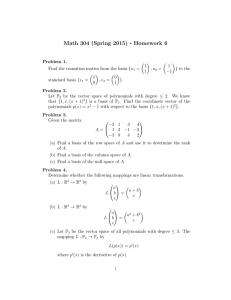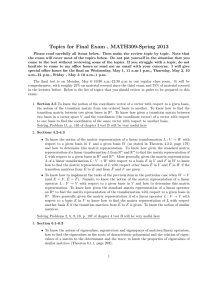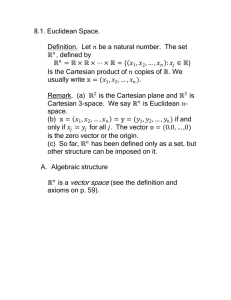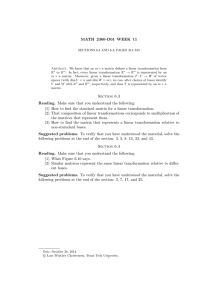Topics for Exam 2, MATH309-Spring 2013
advertisement
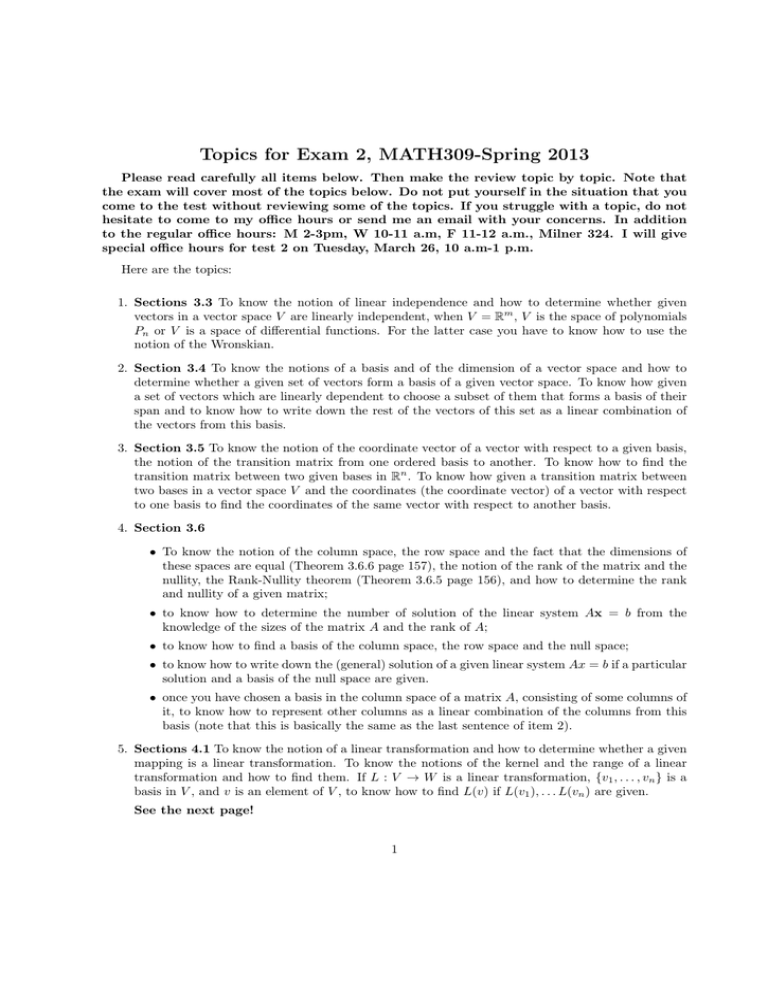
Topics for Exam 2, MATH309-Spring 2013
Please read carefully all items below. Then make the review topic by topic. Note that
the exam will cover most of the topics below. Do not put yourself in the situation that you
come to the test without reviewing some of the topics. If you struggle with a topic, do not
hesitate to come to my office hours or send me an email with your concerns. In addition
to the regular office hours: M 2-3pm, W 10-11 a.m, F 11-12 a.m., Milner 324. I will give
special office hours for test 2 on Tuesday, March 26, 10 a.m-1 p.m.
Here are the topics:
1. Sections 3.3 To know the notion of linear independence and how to determine whether given
vectors in a vector space V are linearly independent, when V = Rm , V is the space of polynomials
Pn or V is a space of differential functions. For the latter case you have to know how to use the
notion of the Wronskian.
2. Section 3.4 To know the notions of a basis and of the dimension of a vector space and how to
determine whether a given set of vectors form a basis of a given vector space. To know how given
a set of vectors which are linearly dependent to choose a subset of them that forms a basis of their
span and to know how to write down the rest of the vectors of this set as a linear combination of
the vectors from this basis.
3. Section 3.5 To know the notion of the coordinate vector of a vector with respect to a given basis,
the notion of the transition matrix from one ordered basis to another. To know how to find the
transition matrix between two given bases in Rn . To know how given a transition matrix between
two bases in a vector space V and the coordinates (the coordinate vector) of a vector with respect
to one basis to find the coordinates of the same vector with respect to another basis.
4. Section 3.6
• To know the notion of the column space, the row space and the fact that the dimensions of
these spaces are equal (Theorem 3.6.6 page 157), the notion of the rank of the matrix and the
nullity, the Rank-Nullity theorem (Theorem 3.6.5 page 156), and how to determine the rank
and nullity of a given matrix;
• to know how to determine the number of solution of the linear system Ax = b from the
knowledge of the sizes of the matrix A and the rank of A;
• to know how to find a basis of the column space, the row space and the null space;
• to know how to write down the (general) solution of a given linear system Ax = b if a particular
solution and a basis of the null space are given.
• once you have chosen a basis in the column space of a matrix A, consisting of some columns of
it, to know how to represent other columns as a linear combination of the columns from this
basis (note that this is basically the same as the last sentence of item 2).
5. Sections 4.1 To know the notion of a linear transformation and how to determine whether a given
mapping is a linear transformation. To know the notions of the kernel and the range of a linear
transformation and how to find them. If L : V → W is a linear transformation, {v1 , . . . , vn } is a
basis in V , and v is an element of V , to know how to find L(v) if L(v1 ), . . . L(vn ) are given.
See the next page!
1
6. Sections 4.2-4.3
• To know the general form of a linear transformation from Rn to Rm (Theorem 4.2.1 on page
176) and how to find the standard matrix representation of such linear transformation (i.e.
the matrix representation with respect to the standard bases in Rn and Rm ) if the linear
transformation is given analytically or geometrically.
• To know the notion of the matrix representation of a linear transformation L : V → W with
respect to a given basis in V and a given basis W (as stated in Theorem 4.2.2, page 179)
and how to determine this matrix representation. To know how given the standard matrix
representation of a linear transformation L from Rn and Rm to find the matrix representation of
L with respect to a given bases in Rn and Rm . More generally, given the matrix representation
A of a linear transformation L : V → W with respect to a basis E in V and F in W to know
e in V and Fe in W if the
how to find the matrix representation of L with respect other bases E
e
e
transition matrices from E to E and from F and F are given.
• To know how to implement the tasks of the previous item in the particular case when W = V
e = Fe). Namely, to know the notion of the matrix representation of a linear
(and E = F , E
operator L : V → V with respect to a given basis in V and how to determine this matrix
representation. To know how given the standard matrix representation of a linear operator
on Rn to find the matrix representation of the transformation with respect to a given basis in
Rn . More generally, given the matrix representation A of a linear operator L : V → V with
respect to a basis E in V to know how to find the matrix representation of L with respect
e if the transition matrices from E
e to E is given. To know the notion of similar
another basis E
matrices.
7. Section 6.1-6.3
• To know the notion of eigenvalues, eigenvectors and eigenspaces of matrices/linear operators,
how to find the eigenvalues as the roots of characteristic polynomial and the relation of eigenvalues of a matrix to the determinant and the trace; to know the properties of eigenvalues of
similar matrices (Theorem 6.1.1, page 293);
• To know the notion of the algebraic and geometric multiplicity of an eigenvalue (will be given
in class of Friday, March 22), diagonalizable and defective matrices/operators and how to
determine whether the matrix is diagonizable;
• In the case when a matrix A is diagonizable to know how to find the diagonal matrix D which
is similar to A and a matrix X which diagonalizes A (in other words, how to factor A into the
product XDX −1 , where D is diagonal by writing explicitly what is D and X)
• To know the notion of the exponential of a matrix. Using the representation A = XDX −1
of the previous item to know how to find Ak for any k and how to find eAt . To know how
to use the latter in order to find the solution of initial value problems for systems of ordinary
differential equation: x0 = Ax, x(0) = x0
It is recommended to review all problems in homework assignments 5-8 and the examples given during
the class on the topics listed above. Also it will be very useful as a part of your preparations to the test
to practice the following problems from the Chapter tests:
Chapter 3 Test A p. 164: problems 6-15;
Chapter 3 Test B, pp. 164-165: problems 1, 3, 4, 6(b), 7, 8, 9, 10, 11;
See the next page!
2
Chapter 4 Test A, pp 196-197: problems 1-4, 6-10;
Chapter 4 Test B, pp. 197: 1-6, 8-10;
Chapter 6 Test A, p 384: problems 1-8;
Chapter 6 Test B, pp. 384-385: problems 1-4, 7.
3

